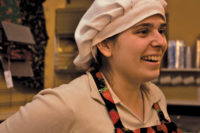Like most of you, I’ve been inundated with emails forecasting consumer trends for 2017. I — as one would expect — look forward to reading them. First, they’re harmless. I mean, how many of you actually recall a trend predicted in January come December? Chances are only a handful.
Second, they can be useful. Either they confirm what you’re seeing in the marketplace and/or inspire you to explore a concept that hadn’t popped up on your computer screen. And as strange as this sounds, a prognostication may even prompt you to do the opposite.
As someone once told me, “For every trend, there’s a counter-trend.”
That said, I’d like to share my thoughts on a study recently released by the Hartmann Group on supermarkets and multichannel shopping. According to the report Cultural Shift: How Consumers Now Use Neighborhood Supermarkets, Americans have become committed multichannel shoppers.
Moreover, “…they have become quite used to evaluating specific stores (and channels) in terms of which specific food and beverage categories they want to obtain from each, based on a complex calculus of relative value. Low-stakes, high-velocity staples move to club or hard discounters. Higher-stakes items move upmarket or to the local supermarket…if it is well run.
“As more and more staple purchases of center-store product have moved to alternative channels, including e-commerce, the net effect has been for consumers to fill their baskets and carts more and more with fresh and special-occasion foods…as well as convenient fill-in purchases. The massive pantry-stocking carts of yesteryear are very hard to see anymore.
“The result is that we are seeing American consumers increasingly use their neighborhood supermarket as they once used specialty stores. And the supermarket chains that have seen this trend early are already shifting their stores upmarket to simulate a specialty-store experience, primarily in the perimeter departments. Kroger, Raley’s and Schnucks are perhaps three of the best examples in the past five years.”
Interesting stuff. Of course, I’ve been a multichannel shopper for the past five years, if not more. It is an interesting calculus, as the Hartmann report describes. On my end, I will typically visit three sometimes four channels on a Saturday, my main food shopping day. And yes, I am the household’s primary food shopper.
First, there’s a fruit and vegetable market near my house — actually I have almost everything nearby — and then I proceed to hit a Polish deli, a wine and liquor chain and occasionally a local supermarket chain.
Sounds crazy? A bit, I admit. But the local fruit and vegetable market — Jerry’s Fruit and Vegetable Market — acts as our mini-supermarket (it carries meat as well) that caters to ethnics (I’m also one of those). It has incredible variety and the absolutely lowest prices. Quality, for the most part is good.
No need to explain the Polish deli. As for Binny’s, that’s our local wine and beer chain in Chicago, again a case of excellent prices. Plus, I know a wine guy there.
Jewel, our local supermarket chain, becomes a stop when the household needs cleaning supplies, toilet paper and such.
Moreover, this list isn’t fixed, except maybe Jerry’s. Costco pops up at least once a month — it’s great place to shop when we’re entertaining as well as getting certain items, i.e. smoked salmon, steaks, shrimp, cheeses, lamb chops, roses, etc.
During the week, I’ll stop by Whole Foods as well as our neighborhood supermarket, Happy Foods. Again, special stops: Whole Foods — fresh fish, cheeses, croissants; Trader Joe’s — breads, wines, salami, cheese.
Oh yes, all these places sell confections and snacks. I can get Loacker’s Quadratini at Jerry’s, Polish chocolates at the deli, bar snacks and chocolates at Binny’s, mainstream candies at Jewel, Valrhona at Trader Joe's, and Vosges chocolate bars at Whole Foods.
So confectioners, large and small, multichannel shoppers mean multi opportunities. I know, easier said than done. Just give this new consumer breed —or in my case, old breed — a reason to add confections to their cart.





